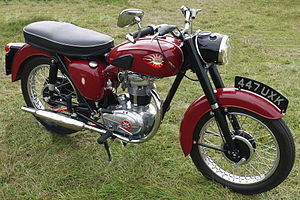 | |
| Manufacturer | BSA Motorcycles Ltd., Armoury Road, Small Heath, Birmingham, England |
|---|---|
| Also called | Star |
| Parent company | Birmingham Small Arms Company |
| Production | 1958–1967 |
| Predecessor | BSA C12 |
| Successor | BSA B25 Starfire, BSA C25 Barracuda |
| Engine | 4-stroke 249 cc (15.2 cu in) OHV single cylinder, alloy head, Amal 375 carburettor[1] |
| Bore / stroke | 67 mm × 70 mm (2.6 in × 2.8 in) |
| Power | 15 bhp (11 kW) @7000rpm[1] |
| Ignition type | Coil with 60 watt Lucas RM13 alternator |
| Transmission | Four-speed, chain drive |
| Brakes | 6 inches (15 cm) front and rear with full width hubs |
| Tyres | 3.25 x 17" front and rear[1] |
| Wheelbase | 51.25 inches (130.2 cm) |
| Fuel capacity | 3 gallons |
The BSA C15 was a 250 cc single-cylinder ohv motorcycle manufactured by the British company BSA from September 1958 until 1967, and was BSA's first four-stroke unit-construction bike.[2] For most of that period, after the introduction of 'Learner Laws' in 1961, a 250 cc was the largest capacity solo machine that a learner could ride unaccompanied when displaying L-plates in the United Kingdom. A road-going Sports derivative was added in 1961, and off-road versions, for Trials and Scrambles, were also available in the range.[2]
Producing only 15 bhp (11 kW), the C15's lack of power meant that it was hard for the BSA to compete with the more sophisticated Japanese motorcycles (such as the Honda C71 and CB72) which began arriving in the UK in the 1960s.[3]
- ^ a b c Motor Cycle Data Book 1960, p.60 George Newnes Ltd., London. Accessed and added 2014-10-21
- ^ a b Motor Cycle, 22 April 1965, pp.508-511 C15 Riders Report collated by Mike Evans. Accessed 2014-10-18
- ^ Kemp, Andrew; De Cet (2004). Classic British Bikes. Mirco. Bookmart Ltd. ISBN 1-86147-136-X.